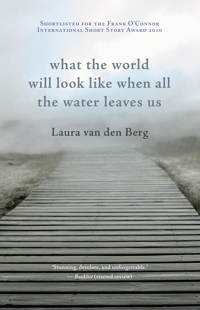what the world will look like when all the water leaves us
 what the world will look like when all the water leaves us
what the world will look like when all the water leaves us
Laura van den Berg
Scribe 2011
ISBN: 9781921640896
$25.95
192 pp
Never judge a book by its cover; I know this but judge it I did – by its cover and by its title. The title (taken from the closing story) misled me, as this is not a book about environmental issues although issues of species survival come up in a few instances. The stories in this collection are about the internal environments of a number of women. A better title may have been taken from the opening story: ‘where we must be’.
Laura van den Berg is North American and all the stories are set either in the USA or overseas with American protagonists. The narrators/protagonists/main characters in all eight stories are women; if they have or had husbands, they have left or they are dead or might as well be; all of the women have difficult or disastrous relationships if they have any. The exotic also forms a thread through most of the stories. This is as tight a collection of short stories I have ever read, with recurring themes and issues binding them into a cohesive examination of relationship (with partners and with parents),seeking oneself and one’s place in the world, searching for meaning in work and the attempt to escape from something through that work. The author places her characters in different situations, which allows her to explore different aspects of the recurring issues and themes.
In ‘where we must be’, Jean works as a Bigfoot impersonator in a costume at Bigfoot Recreation Park in California. This is ‘home-grown’ exotic, compared with later stories which deal with locations outside the USA. To what extent does Jean’s ‘being’ Bigfoot define her? Through all this winds her connection with Jimmy and there is an unspoken wondering if a relationship can define you, and to what extent the costume we wear reflects internal processes. This is also explored in the third story, with masks.
In ‘goodbye my loveds’ the narrator is stuck looking after her younger brother after the death of their parents in the Amazon jungle were they were researching terrestrial primates. She ends up having to choose between relationship/study/career and being there for her brother, who lives much of his life in fantasy.
The author again brings the exotic into the local in ‘we are calling to offer you a fabulous life’. Joyce works in a shop selling Balinese masks, one of which is almost a character in its own right, which gives it something in common with the mythical creatures in some of the other stories. The married man she has an affair with has to choose between Joyce and his pregnant wife, and that is perhaps the least of Joyce’s problems.
‘the rain season’ takes us out of the USA. It is about Catherine, who was sent to the Congo as a teacher by her Church after her husband died in a house fire. The Congo is falling apart violently and Catherine must decide whether to stay or return to the USA. As with three of the other stories, a mythical beast (or is it real?) weaves through the story, symbolic of the deep, inner struggle that Catherine is experiencing.
In ‘up high in the air’ the narrator, Diane, is struggling with a floundering marriage (as her husband pursues the beast he believes lives in Lake Michigan) and her mother (who has progressing dementia). It is an examination of misunderstanding and belief, with the misunderstanding leading to dire consequences. Diane is an etymologist, but can she break through the meaning in what people say?
‘still life with poppies’ is, perhaps, a love story, or maybe not. Having been abandoned by her husband in Paris because of his fears, Juliana is not sure whether to stay or return to the USA. The man who lives across the hallway intervenes.
‘inverness’ again plays around a beast that may not exist and the central character, Emily, is a woman out of her comfort zone and away from home. She is searching for a plant that could be as non-existent as Nessie. It is all about relationships, seeking, disappointment and private worlds.
‘what the world will look like when all the water leaves us’ is a teenage daughter’s story of a claustrophobic relationship with her mother, who travels the world researching threatened species. Celia is also exploring her developing sexuality and her relationship with her father, who went off with a younger woman. The story is set in Madagascar and they have been travelling the world from jungle to jungle, hot and steamy, yet the relationships in the story are arid. Does Celia have it in her to change her circumstances?
Laura van den Berg uses her stories to explore the inner worlds of women who are searching, having lost someone or something external, needing to find something within themselves. Men play peripheral roles in most of the stories, indicating that ultimately we need to find wholeness in ourselves rather than relying on someone else to ‘complete’ us. This applies to men as well as women. The mythical or hard-to-find beasts (and plants) symbolise the difficulty inherent in the quest, the possible dangers (in confronting the monster) and those hidden, dark, steamy places we have deep in our psyche. Sometimes we discover that it is all desert.
© 2011 Daan Spijer
[to receive an email each time a new review is posted, email me: <daan [dot] spijer [at] gmail [dot] com>]
 CLICK HERE to download a formatted PDF of the above post
CLICK HERE to download a formatted PDF of the above post
 See more of Daan Spijer’s writing and his photos at Seventh House Communications
See more of Daan Spijer’s writing and his photos at Seventh House Communications